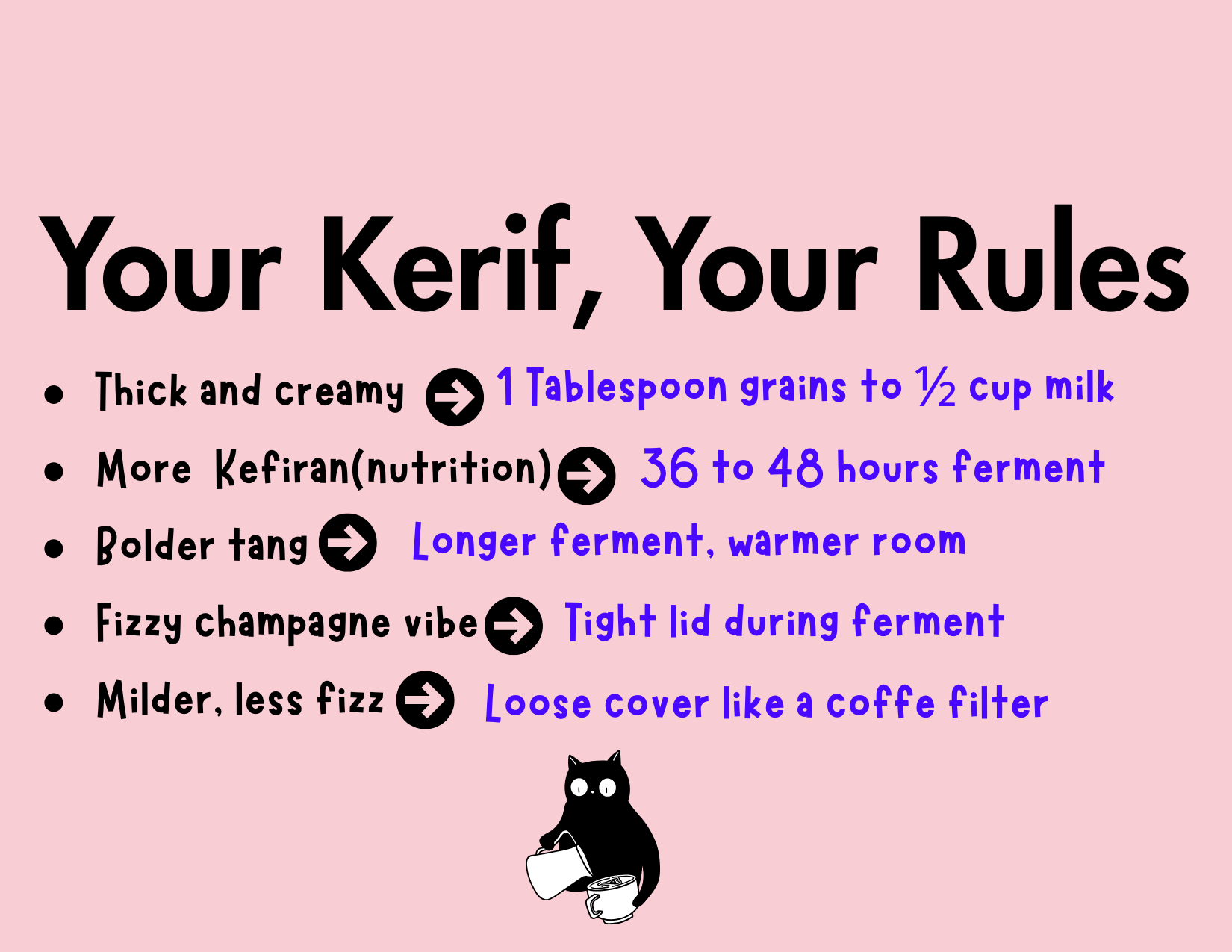- Oct 27, 2025
Kefir's Powerful Matrix - Part 2 At Home
- Jolinda Rockett, BSN, MAc
- Good Food
Once started, kefir makes itself in your kitchen.
Make Kefir at home
The name, kefir, is derived from the Turkish word keyif, meaning “feeling good”. And this is exactly what kefir does! Kefir is a drink that can make you feel good because of its unique taste and flavors but it also improves your wellbeing.
Kefir is a cultured drink you can easily make at home, and it will far exceed the nutritional value of its commercial cousin.
Kefir vs. Yogurt.
Both kefir and yogurt are cultured from milk and it is fair to ask, what's the difference? When it comes to the potential health benefits, it is kefir that scores big over yogurt. Kefir is more than cultured milk, it is a living matrix that outperforms yogurt in clinical outcomes for gut, heart, and immune health.
As we learned in Working with the Kefir Matrix – Part 1, any milk will yield kefir except UHT (ultra-high temperature) will yield nutritious kefir.
Milk is fermented by the addition of a small quantity of kefir grains. These grain-like colonies formed by lactic acid bacteria and yeast have an appearance ranging from a rubbery cauliflower like substance to simple and tiny grains held together in a gel.
Begin kefir-ing in your kitchen.
What You Need
1–2 Tbsp live kefir grains (“wet” — not powder; see Part 1)
2 cups fresh milk (cow, goat, sheep — pasteurized or raw following guidance from Fusion Teas founder. Never use Ultra High Temp (UHT).
Clean glass jar + cover -- coffee filter or gauze + rubber band or a regular lid to increase fizz.
Fine mesh strainer + soft spatula

Step-by-Step
Add grains + milk to a jar. Stir gently.
Cover loosely (lets CO₂ escape and keeps bugs out).
-
Ferment 24–48 hours at 72–78°F (22–25°C).
Warmer = faster. Cooler = slower. Taste after a few hours to see if you want it more tangy.
Stir occasionally — kefir loves oxygen and this gives you an excuse to play with your food.
-
When thick and tangy to your preference, strain it:
Pour through a fine strainer into a glass or bowl to get the drinkable kefir.
Stir the thick matrix in the strainer with the rubber spatula, until you have only the kefir grains. Return these to jar and add fresh milk. Ready to add milk and start again.
-
Repeat forever. (Grains grow 10–20% per batch — share the love!)
It is the magic elixir that contains the health matrix I described in Part 1. Of course, you may add anything to it for a variety of flavors, including honey and juices. Here’s where your creativity can shine.
If you want to cook with kefir, remember the heat destroys the live organisms and greatly reduces the nutritional value but the flavor will be good. It resembles buttermilk in a recipe.
FAQ's
How much milk and how much grains do I use?
Guide: 1 Tbsp. grains for to ½ to 1 cup of milk or as much as 1 cup milk. The kefir will populate the milk but remember that the more grains you use, the more kefiran (nutrition) you will have. Also, the kefir ferments faster with more grains.
Some kefir grains look like cauliflower and some look like little grains of sand. Why the difference?
I puzzled over this for a long time. The first kefir I was given years ago looked like cauliflower and was rubbery. I shared it by pinching it into pieces. Later I received some kefir from a friend, and the grains were small. I found out kefir changes its form because of adaptations to climate, milk type, handling, and ...who knows. It just changes as it needs to.
What if I accidentally get grains in the kefir I’m going to drink?
This is not a problem. You can consume kefir grains. They are a powerhouse of nutrients. Just be sure to save some grains to make new kefir. You don’t want to be out of grains!
How can I keep kefir going when I’m out of town?
1-3 days: Keep in the fridge in milk. The cold slows the fermentation.
2-3 weeks: Keep in a large jar with lots of milk in the fridge.
Longer: Dehydrate the grains by leaving them out to air dry for 2-3 days, or give them to a friend.
It gets hot where I live. Is this a problem?
If you live in a warm climate, make sure the grains are not exposed to high temperatures. If the room temperature is above 85 degrees F, ferment the kefir in the fridge for 48-72 hours.
Should I rinse the grains occasionally?
The matrix is the magic. Rinsing will strip the gelatinous kefiran and disrupts the balance. If they get contaminated, rinse once with milk -- not water -- and nurture them back to their healthy state.
Is there alcohol in kefir?
Kefir contains 0.5 to 0.75% alcohol, similar to overripe fruit. To be safe, limit kids and pregnant moms to 1/2 cup or use brief 12-hour ferments.
Is it Keto-friendly?
Yes! If you are following a diet that recommends eating foods rich in fats, choose full-fat milk.
How much do I need each day?
Start with ½ cup a day and build to 1-3 cups/day. (Others may notice your improvements before you do.)

The “life cycle” of kefir.
In milk, the bacteria and yeast that make up the matrix of kefir grow and multiply. A result of all this growth, lactic acid increases and yields the sour taste. As the solids and liquids in the fermenting kefir develop, they visibly separate. The liquid lactic acid collects in the bottom of the culture jar and curds float and accumulate on top of the milk the kefir. Once these two have clearly separated, the kefir begins to overdevelop or over-ferment. This condition is not bad, and the strained kefir can be enjoyed, but it will taste tangier than you may be used to. Some people like it extra sharp. It’s a personal choice.
Keeping the lid on the active kefir will encourage effervescent bubbles to form. This is also within your control. Allowing more air to escape reduces the fizz. Do you like the Champagne-like bubbly effect? Keep the lid tight.
You may want to drink the strained kefir immediately or chill it in the refrigerator to drink later. Many people prefer the pleasant flavor after it has chilled and developed further. Your strained kefir will stay fresh for days.
Another way to enjoy kefir is to drop some berries or a piece of apple into the kefir after it has been strained. Let it sit out on the counter for about 3-4 hours or longer in the fridge. This is called double fermenting. The fruit adds flavor nuances and additional nutritious qualities.
Summary: Why Kefiran Matters
Kefiran is the reason kefir outperforms yogurt in clinical outcomes for gut, heart, and immune health. It is easy to make and maintain and be benefits are amazing.
Want to talk about it? More questions or share your helpful hints? Make a comment to this post and we'll start a Kefir Kommunity (if this is taking cute over the line, sorry, I couldn't help myself). Are you in? Tell me.
